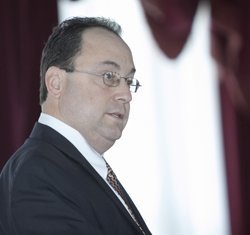By Ana Rodriguez Soto - The Archdiocese of Miami

Photographer: ANA RODRIGUEZ-SOTO | FC
Victor Andres Triay, professor of history at Middlesex Community College in Middletown, Conn., is the author of "Fleeing Castro: Operation Pedro Pan and the Cuban Children's Program," a scholarly history of the exodus. He grew up in Miami and is a graduate of Christopher Columbus High School.
�I did not know that there were 14,000 of us,� said Carlos Eire, a professor of history at Yale and a child of Pedro Pan who has authored two books on his experience, �Waiting for Snow in Havana� and �Learning to Die in Miami.�
�Nobody in Cuba called it Operation Pedro Pan,� said Victor Andres Triay, a professor of history at Middlesex Community College in Middleton, Conn., and author of �Fleeing Castro: Operation Pedro Pan and the Cuban Children�s Program.�
�It was an evolutionary process. It happened across the board in different places at different times,� Triay said.
On the Cuban side, the plan originally entailed getting 200 children out of the island whose parents were involved in anti-Castro activities. They were worried about what would happen to their children if they were killed or captured, so they approached James Baker, the headmaster of Ruston Academy in Havana. His initial solution was to open a boarding school for them in Miami.
At about the same time, in November 1960, a 15-year-old named Pedro who had been sent out of Cuba to live with relatives in Miami arrived at the office of an Irish-born Miami priest, Father (later Msgr.) Bryan O. Walsh. He directed the Catholic Welfare Bureau (now Catholic Charities), which was then primarily a child care and adoption agency with about 80 children under its care.
Pedro�s relatives had been unable to take care of him, and he had been found living in the streets, rail-thin from lack of food.
�Walsh saw this as an indication of things to come,� said Triay. �Walsh perceived correctly that this was going to grow.�
Somehow Baker met up with Father Walsh, who suggested that, instead of a boarding school, Baker should send the children to Miami with student visas. They would be enrolled at Coral Gables Senior High School and religious agencies such as the Catholic Welfare Bureau would assume responsibility for their care, with the federal government providing the funding.
�At the time, nobody could imagine what it was going to turn into,� Triay said.
The first list of students that Baker sent Msgr. Walsh contained 125 names. No one knew if they would come all at once. Msgr. Walsh expected them on Christmas day 1960 but the first two arrived a day later.
Meanwhile, in Cuba, there were rumors that �Castro was going to announce that no more children would be allowed to leave,� Triay said. A group of 100 children already had been sent to Russia, fueling even more rumors that the government would take away patria potestad � the right of parents to raise and educate their own children.
On Jan. 3, 1961, the U.S. embassy in Havana shut its doors. With no possibility of obtaining student visas, it seemed the exodus was over, Triay said.
SEE RELATED STORIES
But Baker had left people in Havana � people with connections to KLM and Pan American Airways, people with connections to the British embassy � who were working on ways to get the children out through Jamaica, where they could obtain student visas for the U.S.
At the same time, a State Department official raised the possibility of issuing visa waivers � a piece of paper waiving the requirement for a U.S. visa due to an emergency situation.
Msgr. Walsh got �blanket� authority to issue those waivers to any child between the ages of 6 and 16. He sent these with only his signature to Cuba, where people could fill out the rest of the information. In Cuba, they were copied and distributed by a vast underground that included Catholic schools, local priests and diplomats. So many were handed out that when the Havana-Miami flights ended in 1962, an estimated 80,000 children had visa waivers they were unable to use.
�Most of the visa waivers had a copied signature,� Triay said. �Phony visas� also were being made in Jamaica, and for a few months, until the Cuban government stopped it, airlines could fly the children out by simply confirming that a visa waiver was waiting for them in Miami.
The trickle of unaccompanied children turned into a flood by the spring of 1961, after the failure of the Bay of Pigs invasion. By then, Castro had expropriated all private businesses, shut-down all the private and religious schools and expelled the priests and religious who ran them.
The camps in South Florida then turned mostly into processing centers where the children were housed until more permanent arrangements could be made. About half of the children who arrived were sent immediately to live with relatives already in the U.S.; the other half were housed in small group homes, foster homes, orphanages and boarding schools throughout the U.S.
Ultimately, Msgr. Walsh contracted with 95 licensed child care agencies in 35 states, Triay said. He also made sure that children who were not Catholic � about 300 were Jewish and 700 were Protestant � were delivered into the hands of Protestant or Jewish agencies.
By 1966, less than a year after the start of the Freedom Flights, only about 500 Cuban children remained in foster homes or orphanages, Triay said.
He noted that �there is a fight over history about this,� with some claiming that the CIA used scare tactics to launch the exodus as a means of embarrassing Castro.
�Everything the parents predicted was going to happen happened. And maybe even worse than they could have imagined,� said Triay, referring to Communist indoctrination and the loss of parental rights. �They didn�t have to send children to Russia. The Soviet Union was brought to Cuba for them.�


Comments from readers